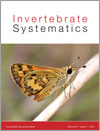Birds harbour a wide array of other taxa in their nests or in their plumage, which either have an ectoparasitic or commensal relationship with the host. We report on the discovery of a cheliferid pseudoscorpion found in the plumage and nests of the sociable weaver bird (Philetairus socius) in southern Africa. The nests of these communal birds are the largest of any bird, and may contain up to 500 individuals. The pseudoscorpion is likely to have a mutualistic relationship with the birds, most likely preying on other small invertebrates in the nests. Molecular data derived from two populations of the pseudoscorpion found divergence levels of 1.1% in cytochrome oxidase 1 (CO1), and an analysis of CO1 and two rRNA genes (18S and 28S) found a close relationship with Chelifer and Parachelifer in the tribe Cheliferini, which is supported by the morphology of the male genitalia. The molecular analysis also suggests that Beierius may not belong to the Cheliferini. The pseudoscorpion found in association with the sociable weaver represents a new genus and species, Sociochelifer metoecus Harvey, sp. nov.
How to translate text using browser tools
30 October 2015
A novel symbiotic relationship between sociable weaver birds (Philetairus socius) and a new cheliferid pseudoscorpion (Pseudoscorpiones : Cheliferidae) in southern Africa
Mark S. Harvey,
Patricia C. Lopes,
Gregory R. Goldsmith,
Ali Halajian,
Mia J. Hillyer,
Joel A. Huey
ACCESS THE FULL ARTICLE

Invertebrate Systematics
Vol. 29 • No. 5
October 2015
Vol. 29 • No. 5
October 2015
morphology
Namibia
phoresy
South Africa
taxonomy




